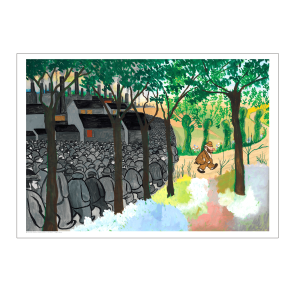Kepler-186f is the first exoplanet (planet outside our solar system), which is roughly the same size as the Earth and which is at the same time in the habitable zone of its star. Kepler-186f's star, however, is significantly different than our Sun, as it is a significantly colder, red star. This means that if there is plant life on the planet, it would most likely be red (as illustrated on the poster), as red plants better utilize red-wave light. The man behind the poster, Joby Harris from NASA's Jet Propulsion Laboratory Department, has commented on the poster's design as a result of a crazy whim. That the vegetation could be red is good enough. But the well-known, white fence that he has chosen to place across the poster is intended to make people stop and pull on the smile band. There is something acidic and unreal about seeing such a well-known object, in such an environment as an exoplanet with red vegetation. "Where the grass is always rescues on the other side" supports the poster's mix of familiar and unknown. That the grass should be red is a fun element in an otherwise well-known proverb. The white picket also has a symbolic meaning. The two people standing inside the fence look over it. One even points to the woods, which we cannot see hiding in. They stand on the well-known grounds, and look beyond the limitations (fence), toward the unknown and new, waiting for them out there. In the same way, we sit down here on Earth and look out towards the room. Could the two people on the poster intend to climb over or do they just dream? Are they scared or are they excited? Full of horror or expectation? These questions cannot be answered from the poster - but they may be very good to think about in relation to our own situation. Are we, mankind, ready to do everything to take the space? Or do we just have to fantasize and dream about it a bit yet? Asking NASA is not that simple. In NASA's eyes, the imagination has always been the starting point for action - especially when it comes to technological inventions and intergalactic discoveries. The first step is to dare to dream. The next step is to begin investigating how the dream can come true.





